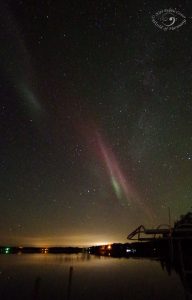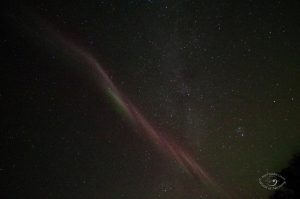
The power of the internet has provided scientists and citizen scientists with the ability to see, report, and analyze a feature visible in aurora, but up until now didn’t have a name. Often prematurely referred to as a “proton arc”, this isolated auroral arc is being called “Steve.”
In the children’s movie “Over the Hedge”, a character isn’t sure what he is looking at and randomly names it Steve. An online community wasn’t certain what they were photographing and sharing, so the moniker “Steve” was used for this phenomena and it has since stuck.
At a recent Swarm science meeting in Canada, Professor Eric Donovan from the University of Calgary explained how this new finding couldn’t have happened 20 years ago when he started to study the aurora. “In 1997, we had just one all-sky imager in North America to observe the aurora borealis from the ground. Back then we would be lucky if we got one photograph a night of the aurora taken from the ground that coincides with an observation from a satellite. Now we have many more all-sky imagers and satellite missions like Swarm so we get more than 100 a night.”
Swarm is the fourth in series of pioneering Earth Explorer research missions from the European Space Agency (ESA) , following on from GOCE, SMOS and CryoSat. It is also ESA’s first constellation of satellites to advance our understanding of how Earth works. Using technology provided by both Canada and Europe, three identical Swarm satellites are measuring the magnetic signals that stem from Earth’s core, mantle, crust and oceans, as well as from the ionosphere and magnetosphere. By analyzing the different characteristics of the observed field, this mission provides insights into space weather caused by solar activity. (Learn more about another exciting ESA satellite here.)
At the Swam science meeting, Professor Donovan also met members of a social media group on Facebook: the Alberta Aurora Chasers. The group attracts members of the general public interested in the night sky, ranging from star gazers to aurora fans. Many in social media, including Alberta Aurora Chasers, use the Aurorasaurus website and app which connects citizen scientists to scientists around the world and seeks out Twitter feeds for instances of the word “aurora”. In doing so, it does a very good job of forecasting where auroras will be most visible.
The Aurorasaurus project was formed several years ago by Dr. Elizabeth MacDonald, who is a program scientist in the heliophysics department at NASA and also on detail in the Geospace Physics Laboratory at NASA Goddard. Her goal was to develop an organization where everyday citizen-scientists could communicate with others just like themselves and interact with professionals like Dr. MacDonald about their experiences with auroras. This is a mutually beneficial arrangement, as the citizen-scientists get to learn more about auroras while the professionals observe what and where these people are seeing.
After reviewing photographs shared in social media, Professor Donovan stumbled across something he hadn’t seen before: unusual streaks of purple and green light. Some photographers referred to these light shows as “proton arcs”, but for a number of reasons, including the fact that proton aurora are never invisible, Professor Donovan knew it was something else. Many simply referred to the phenomena as “Steve” and the name has stuck.
“I would say because we’ve had more eyes on the sky and people are more connected than ever before,” Dr. MacDonald told us about the recent buzz about Steve and aurora. “Observers can share with each other through social media groups and also contribute to citizen science efforts like Aurorasaurus. It is through our citizen science group that the amazing enthusiast group of Alberta Aurora Chasers who documented the Steve phenomena met scientists from Aurorasaurus and colleagues at the University of Calgary, which is right in their own backyard. Now we are working on this new discovery together.”
Professor Donovan was able to match ground sightings of Steve documented in social media to an overpass of one of the three Swarm satellites. In a statement released from ESA, Professor Donovan said, “As the satellite flew straight through Steve, data from the electric field instrument showed very clear changes. The temperature 300km (186 miles) above Earth’s surface jumped by 3,000°C (5,432°F) and the data revealed a 25 km (15.5 miles) – wide ribbon of gas flowing westwards at about 6 km/s (13,400mph) compared to a speed of about 10 m/s (22,400mph) either side of the ribbon.”
“Steve has been observed as far south as Michigan and Montana. It is not rare, being seen about 50 times last year over Canada. We do not fully understand the conditions that allow it to be seen yet,” added Dr. MacDonald.

There also appears to be a seasonal component to Steve that is not completely understood, according to Dr. MacDonald. “There are seasonal effects in both composition of the atmosphere and the strength of solar storms due to the tilt of the Earth on its axis. Steve has a strong seasonal effect we do not fully understand yet.” Steve was not observed at all between October 2016 and February 2017 and this seasonal component is thought to have caused this.
The colors of Steve and its orientation across the sky are unique. According to Dr. MacDonald, “The green (color of Steve) is likely the usual auroral green, though possibly excited in unusual ways. The purple may be somewhat different than the usual auroral colors. Steve appears to be (oriented the way it is because of) an east-west aligned stream of charged particles in the atmosphere that corresponds to a boundary in outer space when traced out in 3 dimensions along the Earth’s magnetic field lines to the ecliptic place.”
Scientists, citizen and otherwise, are eager to see what new discoveries will come from social media.
“This idea (Aurorasaurus) began with a storm that was widely visible—that’s when I joined Twitter in 2011 and saw new possibilities,” said Dr. MacDonald. “There are many goals, centered around improving knowledge of where and when the Northern and Southern Lights will be visible for the public and as ‘ground-truth’ to help improve and validate the coarse statistical models of the aurora we currently have. Also, there are rare types of aurora and citizen scientists individually and collectively can make discoveries and help document these with their eyes, minds, and cameras.”